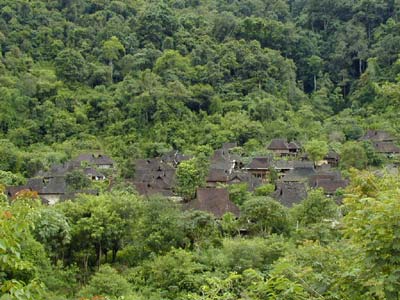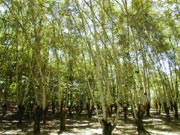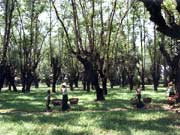 |
|
Hani Villages in the Sea of Forests |
|

|
 |
|
Jinuo Villages(Bapo) |
In spite that the Dai folks have the proverb "foams flow with waves, and the Dai folks migrate with water"; as a matter of fact, they try to find a better forest before they are going to inhabit in a certain place; and they are actually a nation of the forests. To select forests have some advantages for their daily life: first of all, if they select their dwelling place beside a forest, they can obtain various forest products to satisfy their needs in daily life, such as wood, food, and medicines etc; secondly, if they select their dwelling place beside a forest, they can continue their "slash-and-burn" living style and realize the "alternative cultivation" of forests and grains; besides, they can also grow rice by making use of the water flowing out from the forests; thirdly, if they select their dwelling place nearby a forest, their villages will enjoy a better forestry environment, and thus can help them to block off the storms and the tropical heat. Under such circumstances, all ethnical groups voluntarily have a good feeling for the forests beside their villages, and some even protect the forests by assigning them the title -"the forests on holy mountains".
 |
|
Firewood of the Dai Folks
|
As nations in the forests, the ethnical people grow various plants in or beside their villages. For example, the Dai folks must plant some banyan
(Ficus altissima) trees and the holy trees papal (Ficus
religiosa) in their villages in the hope of getting the asylum of gods and Buddha. Besides, they also plant fruit trees, spice trees, woody vegetables, medicinal plants, and rare woods such as
Tectona grandis, bamboos and firewood in these places. In this way, each village looks like a botanical garden where the trees are verdant and the flowers are fragrant; the local folks can enjoy the beautiful environment, and they can also harvest some forest products.
 |
 |
|
The Firewood of the Dai Folks
(Cassia siamea) |
The Firewood of the Dai Folks
(Cassia siamea) |
In the surrounding areas of the Dai villages, we can also find stretches upon stretches of cassia siamea trees, which have fully blossoming yellow flowers, huge and peculiar shapes. They are the firewood of the villagers. The Dai minority is the only ethnical group that plants firewood in China and their firewoods are also unique landscapes of Xishuangbanna. Cassia siamea originates from Thailand, and the local people introduced them into Xishuangbanan a couple of hundred years ago. The Dai folks find it suitable for the biological environment in Xishuangbanan, because it has stubborn sprouting vitalities; after its twigs and branches are cut off, they will grow out many new branches and twigs in a very short period of time, which can be cut again in two or three years; therefore, it is also called "the tree of cutting" in Xishuangbanna. The local people find that it is a kind of very good fuel plant; it has high quantity of heat and is quite flammable; more, it does not has flying ashes during burning, and this is particularly suitable for burning in bamboo buildings. As long as a family plants dozens of such trees and cuts them in turn, they can get sufficient fuels for their daily cooking all the year round. The tree also has a peculiar property, i.e. old trees also have very strong bourgeoning forces, thus they can be used continuously. Why do the Dai folks still plant firewood when there are so many forests beside their villages? The answer is: besides cassia siamea is a kind of superb firewood, their selections also have relations with their ancestors' teaching. The teaching goes: "there won't be any water without forests, there won't be any fields without water, there won't be any grains without fields, and mankind can not survive without grains".


|